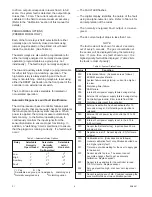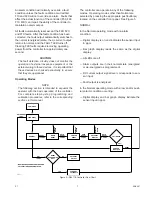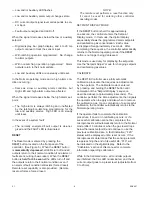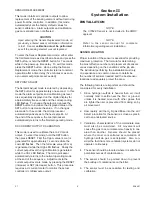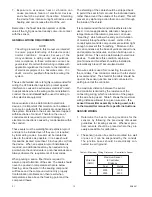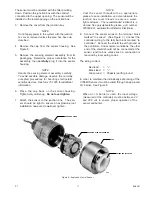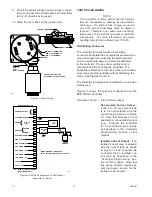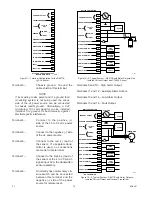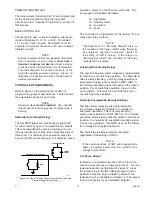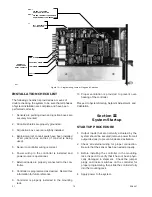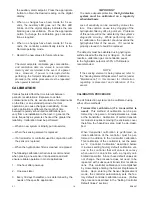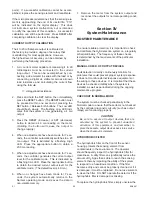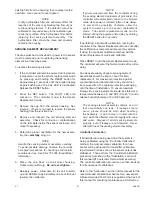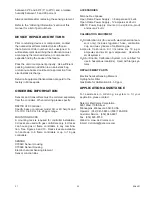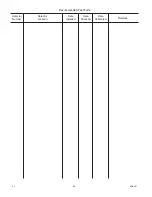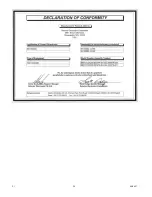
95-8401
20
2.1
point). If a successful calibration cannot be accom-
plished, replace the sensing element and recalibrate.
If the microprocessor determines that the sensing ele-
ment is approaching the end of its useful life, “F10”
will be indicated on the digital display. This does
not indicate a system malfunction, but is intended
to notify the operator of this condition. A successful
calibration can still be performed. Press RESET after
completing calibration to clear the display.
CURRENT OUTPUT CALIBRATION
The 4 to 20 milliampere output is calibrated at
the factory to provide a degree of accuracy that
is satisfactory for most applications. However,
the highest level of accuracy can be obtained by
performing the following procedure.
1. A dc current meter capable of measuring 4 to 20
milliamperes must be connected to the current
loop output. This can be accomplished by con-
necting a dc ammeter in series with the load or by
connecting a digital dc voltmeter across a known
load resistance and calculating the current fl ow
using the formula:
I = voltage/load resistance.
2. Press
and
hold
the SET button, then
immediately
press the RESET button. (The RESET button must
be pressed within one second of pressing the
SET button.) Release both buttons. The Low
LED
should fl ash slowly. The fl ashing Low LED indi-
cates that the system is now generating a 4 ma
output.
3. Press the RESET (increase) or SET (decrease)
button to obtain a 4.0 ma reading on the meter.
(Holding the button will cause the output to
change rapidly.)
4. When no adjustments have been made for 7 sec-
onds, the controller automatically switches to a 20
ma output. This is indicated by a fl ashing High
LED. Press the appropriate button to obtain a
20.0 ma reading.
5. When no adjustments have been made for 7 sec-
onds, the controller generates the current output
level for the calibrate mode. This is indicated by
a fl ashing CAL LED. Press the appropriate button
to obtain the desired current output level for the
calibrate mode. (The default level is 4.0 ma.)
6. When no changes have been made for 7 sec-
onds, the system automatically returns to the
Normal operating mode and saves the data in
non-volatile memory.
7. Remove the meter from the system output and
reconnect the outputs for normal operating condi-
tions.
Section IV
System Maintenance
ROUTINE MAINTENANCE
To ensure reliable protection, it is important to check
and calibrate the H
2
S detection system on a regularly
scheduled basis. The frequency of these checks
is determined by the requirements of the particular
installation.
MANUAL CHECK OF OUTPUT DEVICES
Fault detection circuitry continuously monitors for
problems that could prevent proper system response.
It does not monitor external response equipment or
the wiring to these devices. It is important that these
devices be checked initially when the system is
installed, as well as periodically during the ongoing
maintenance program.
CHECKOUT IN NORMAL MODE
The system must be checked periodically in the
Normal mode to ensure that those items not checked
by the controller diagnostic circuitry (such as output
relays) are functioning properly.
CAUTION
Be sure to secure all output devices that are
actuated by the system to prevent unwanted
activation of this equipment, and remember to
place these same output devices back into service
when the checkout is complete.
HYDROPHOBIC FILTER
The hydrophobic filter on the front of the sensor
housing protects the sensing element from
contaminants in the environment. The operator
should frequently inspect the hydrophobic filter for
cleanliness. A dirty filter can significantly reduce the
amount of H
2
S gas that is able to reach the sensing
element, thereby impairing the ability of the system
to respond to a hazardous condition. If the filter
becomes dirty and cannot be properly cleaned or if it
is damaged, it must be replaced. Do not use solvents
to clean the filter. DO NOT operate the detector if the
hydrophobic filter is damaged or missing.
To replace the hydrophobic filter, simply unscrew the

